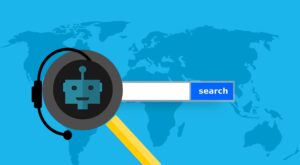
Generative AI: A Digital Double-Edged Sword
The benefits of embracing artificial intelligence (AI) are apparent. Already, the software is providing previously unimaginable service to many industries, such as speeding access to healthcare, streamlining education processes, and resolving previously unsolvable problems. However, as bright as its promise appears to be, the programming also poses significant threats to the entities that rely on it for both work and life functions, including today’s typical consumers. Any person or company that enjoys the assets offered by AI should also be aware of its vulnerabilities so that they don’t become victims of the burgeoning AI crime sector.
A Wolf in Sheep’s Clothing?
Generative AI (GenAI) is a subset of the same programming that provides ‘traditional’ AI functions. They are both ‘trained’ software programs, meaning that they are each designed to pursue specific goals in relation to the also particular parameters of their developer’s strategy. Both styles scour billions of data bits to locate appropriate responses to user demands, and each provides data collection, analysis, and computing capacities that are far beyond those of humans.
However, the two AI aspects differ in one crucial way, and that difference is what makes GenAI so much more dangerous than the other:
Traditional AI offers responses based on the existing data within and the structure of its databases. It can only respond if that data is contained within its research resources.
GenAI, on the other hand, can create responses that are original to its search-and-create process. It takes existing information and spins it into creative narratives that are totally unique to it. It uses existing data as a learning template to develop new and original ‘thought.’ The challenge arises from the fact that it is often impossible to tell a human-generated piece of content from that generated by the computer. Consequently, since computers are not bound by the very human-mandated principles of ethics and morals, their products can appear completely valid and authentic even though they are rife with falsehoods and completely unreliable.
Simply put, GenAI can act as an independent ‘person’ by producing original content with the same sense of authority and integrity as that produced by its human counterpart but without adherence to the rules, regulations, and standards that bind that human effort.
Creative Chaos Ensues
The application of GenAI for less-than-honorable purposes is already rampant:
‘Deepfakes’ are images generated from real pictures that manipulate their truth into something it is not. This type of GenAI often combines data from a variety of sources to create a plausible, realistic ‘new’ version of those combined concepts. Nefarious operators often distort images of political figures (as examples) to reflect a depiction of their personal philosophy, thereby misleading their consumers into believing that the revised version is a truthful one.
‘Phishing’ offers another opportunity to distort or bury the truth from trusting users. Phishing activities typically use email or text prompts to entice consumers into clicking on links that appear to come from a trusted source and that offer a valuable and welcome service. However, those links actually direct the user into a ‘dark’ space on the ‘web where their confidential, personal information – birthdates, banking info, healthcare specifics, etc. – is quickly extricated and stolen.
ChatGPT is, perhaps, the best-known example of GenAI. This software produces human-like results that are often indistinguishable from those presented by actual humans. To users who are not aware of the concern, ChatGPT’s creative products are frequently accepted as valid and authentic, as if a person, not a machine, generated them.
There are many ways for nefarious GenAI to manipulate the community to achieve its developer’s intended goals:
Manipulating images also frequently violates copyright rules, as the developers rarely seek out the trustworthy source of their information. Organizations that use GenAI programming to pursue their proprietary ambitions might unknowingly run the risk of compromising another entity’s legally protected assets.
‘False’ images created with GenAI can also amplify existing biases and prejudices, making current social issues even more dangerous. A recent analysis of ~5,000 pictures created using text-to-image software (a form of GenAI) revealed that the images generated showed extreme gender and racial stereotypes. Unsuspecting viewers might believe that those destructive distortions are actually verified versions of reality.
As noted above, inappropriate disclosure of sensitive information is also problematic when the computer program doesn’t discern it or won’t conform to the boundaries designed to protect that data.
Harnessing GenAI for Good
GenAI still offers users tools to achieve their goals and ambitions despite the threat of misuse and exploitation marring its opportunity. By carefully learning and following directives for appropriate and valid GenAI uses, every entity can maximize the value provided by the software while reducing their exposure to inappropriate outcomes:
Use only publicly available GenAI tools. There are commercially available software packages that facilitate exceptional AI functions without exposing users to the challenges of the format. Many of these digital programs are designed to address the demands of specific industries, as well, so adopting the technology might also be a mandatory step to retain the company’s current market share.
Invest in customization services. Every organization operates differently from its competitors, and those distinctions are also often its unique ‘claim to fame’ within its sector. AI programming can be modified to both protect and highlight the existing presence while also adding new values and opportunities for consumers.
Add data feedback and analysis tools to ensure the software is – and remains – on target for its purpose. Data in all its forms is the true currency of society these days; corporate databases contain myriads of unexplored information that can be harnessed to produce even more success for the company. AI programs will use that newly discovered data to refine their functions, providing even more value to the enterprise.
Both traditional and generative AI offer tremendous benefits as well as potential threats to every organization. Accordingly, the process of adopting the technology and adapting it for proprietary use should be carefully mapped out and managed. Those companies that master the project can also gain significant advantages in a sector where such advances may still be unexplored, which was, after all, the purpose behind the development of artificial intelligence in the first place.


